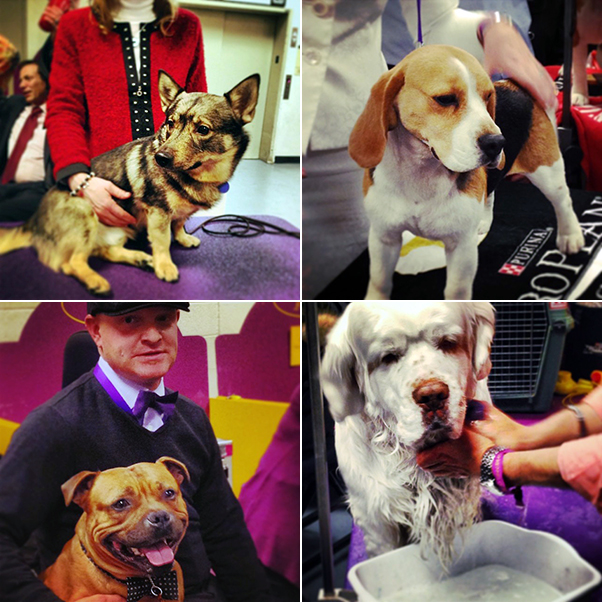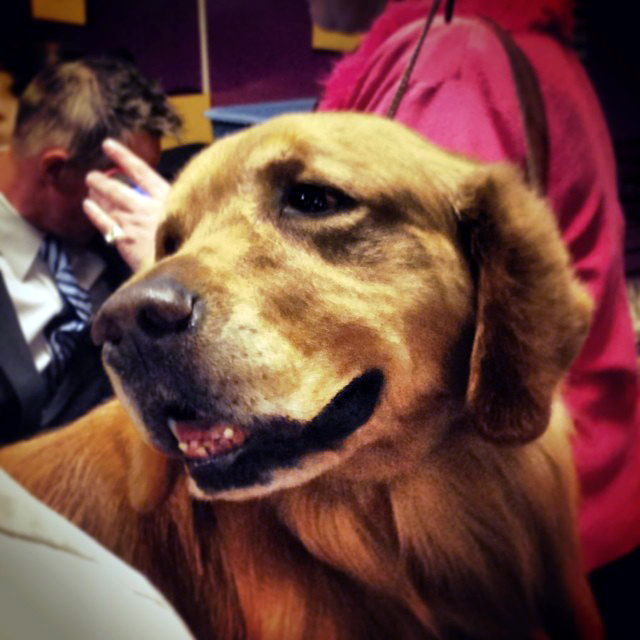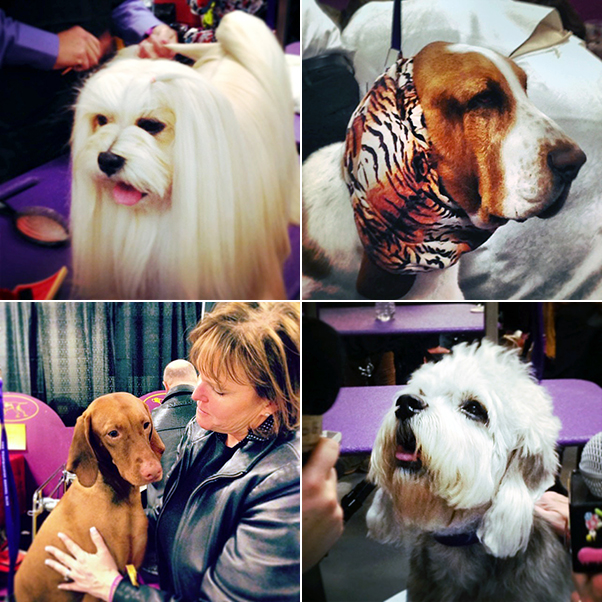The Westminster Kennel Club dog show, at its core, is a celebration of tens of thousands of years of domestication. The second-longest continuously held sporting event in the United States (behind only the Kentucky Derby), the show was started in 1877 as a showing of dogs as working animals, particularly gun dogs, like the setters and pointers who accompanied hunters and terriermen in the field. The formal show, which takes place on the floor of Madison Square Garden every year, is focused on evolutionary traits: Dogs are judged against their breed standards, from appearance to temperament, based on what judges perceive to be an “ideal” specimen.
While most dogs are bred primarily for companionship, Westminster judges still look for the physical characteristics of each breed, from gait to jawline, to determine whether a contender can still perform the functions it was conditioned to over generations of selective breeding. It’s the Olympics of the animal kingdom, but also, on a certain level, a celebration of man’s mastery over the natural world.
It’s the Olympics of the animal kingdom, but also, on a certain level, a celebration of man’s mastery over the natural world.
The Westminster show started at the very moment the friendship between man and dog began to undergo a substantial transformation. While dogs were initially domesticated somewhere between 30,000 and 15,000 years ago (exact date and method of conditioning are still subject to heated debate by archaeologists and evolutionary biologists), hunting and herding dogs have always doubled as partners, and social elites frequently kept dogs as companions (you can blame the bourgeoisie of Victorian England for some of the stranger breeds we see today).
But in 19th-century American cities, the rise of dogs as household pets paralleled the decline of raising livestock. The emergence of industrialization and an urban society shifted our treatment of dogs; they became companions first, employees second.
Humans have always had an affection for dogs on a “moral” level—philosopher Mark Rowland notes that most dog owners are guilty of an “anthropomorphic delusion” by casting their pets as “loyal,” “trustworthy,” or “good”—but for millennia the basis for our relationship to our canines remained fundamentally rooted in accomplishing certain tasks: hunting, tracking, surviving. In the long relationship between humans and canines, the 19th century was the one in which dogs moved from laborers to members of the family.
In a sense, there were two dog shows taking place in Madison Square Garden. On the floor of the Garden, I sat and watched the nation’s most efficient hunters and trackers, with keen noses, powerful mandibles, and agile paws, plod across the kennel club’s signature green carpet. But downstairs in the benching area, where dogs and their handlers prep for their performance, these fine specimens are nothing but soft, friendly, and loyal pals waiting for a treat and a pat on the head. Hidden from the stands of the Garden and the viewers at home watching (exclusively) on the USA Network, the dogs are just dogs as most of us know them today.
This is what I discovered while winding my way through the stadium, stinking of fur and saliva and overpriced whiskey: upstairs, the NFL draft; downstairs, the prom for man and his best friend. And people love going to prom.

“YES, THAT’S A BUSY Bee,” says Chris Wood. We’re standing in the benching area on the fifth floor of Madison Square Garden, a giant concrete swath ringed with kennels, folding chairs, and grooming stations for the hundreds of dogs that will compete this week. To our right, Wood’s wife strokes Orion’s Guitar Hero, the couple’s Great Dane, as onlookers snap photos. “Our handlers got it for us last night, as a joke.”
Wood is holding a stuffed bee, a replica of the dog toy whose disappearance triggered a meltdown between the uptight Parker Posey and Michael Hitchcock in 2000’s Best in Show, long considered the perfect parody of dog show culture. With dual lip piercings and a sleeve of tattoos, Wood doesn’t resemble Posey and Hitchcock’s uber-preppy control freaks (Posey was in attendance at this year’s show). Orion’s Guitar Hero, he tells me, was the first of his color (mantled) to win best of breed for Great Danes. Like an idiot, I ask him if he’s a fan of Best in Show.
“Oh, of course,” he says with a wry smile. “Look around, man. Think about where you are.”
I realize that the number of people in the room has tripled while I’ve been ogling Orion’s Guitar Hero. Thousands of people attend the Westminster dog show every year, and almost all of them flow through the benching area during the two hours before the floor show to meet the breeders and dogs in person.
Down in the benching area, virtually every attendee is reduced to a cooing heap of warm feelings by the gentle, friendly dogs lining the walls. The room swells like a crowd at a rock concert, a packed, pulsating mass slowly rotating counterclockwise around the room. The crowd gets stuck on certain breeds: the 13- and 15-inch beagles, the golden retriever (I overhear a fashion photographer with a side fade and patchy mustache refer to it as “the panty dropper of sporting dogs” before a CBS crew shows up for a shot), and the St. Bernard are particular crowd-pleasers. The blonde and black Labradors, situated at the end of the benching area that feeds into the area, are creating a fire hazard: Labs have been the most popular breed in America for the past 23 years, and the pups are obscured by a forest of black-clad arms dotted with tennis bracelets and iPhones, seeking a quick snap of their faces.
The makeup of Westminster attendees is decidedly upper class. “It was a magnificent triumph for the dogs and for the projectors of the show,” wrote Forest and Stream, a magazine devoted to sporting, after the first show in 1877. “We question if on any previous occasion has there ever assembled in this city such a number of people at one time, and representing as much of the culture, wealth and fashion of the town.” I spy a lot of conservative yet stylish suits and dresses and some sophisticated jewelry. While hunting for the West Highland white terrier, I overhear Bad Mustache refer to the circuit as “some real Upper East Side shit.”
It’s like someone threw a cocktail hour in a PetSmart.

Every person I talk to has come to Westminster for a different reason. This is Christina Castro’s seventh time, although she missed the last two years. Castro works for Eleventh Hour Rescue, a New Jersey shelter for dogs with a high kill rate. “I come here to learn about dogs. About their temperament.” She smiles, keeping her eyes on the magnificent Shar-Pei squinting at us from his pod. “The more I know about a dog, the easier it is to help people find dogs that match who they are.”
Martha Cates of Dallas, Texas, ended up here by accident: she came to New York with a local women’s group and dropped by between sites. A former German shepherd owner, she bristles at the sight of one in her kennel. “That dog needs a much bigger cage,” she says. “They need space. They need to be free. Look at that face! He wants to come out and say hi to us.”
Joy Gazzolli nods in agreement. A New Yorker, she’s at Westminster just because she loves dogs. “I have children. I have grandchildren. My dog is the love of my life,” she laughs. “I live in a building where everyone has dogs, and when one passes there’s always a period of mourning.”
When talking to breeders, nobody seems to show much interest in where their dogs competed last, or who their parents were. The attendees are more interested in knowing how old this Bernese mountain dog is, and who’s a good boy. Most people here are dog owners themselves, and they jump at the chance to laugh with breeders over the idiosyncrasies of their pets.
“I can’t believe how well-behaved this little monster is,” says a woman in a black pea coat as she strokes Winston (or “Win-Tin-Tin”), a basenji. “My dog is a total anarchist.” “I’ve had this breed for 30 years, and I’ve never had one with this temperament,” says Julie, Winston’s breeder and one of the two “Basenji Sisters” who compete in shows across the country. “Her mother is the worst. She gets into everything … but she does it because she knows I like it.”
Across the way, a gaggle of teenage girls are taking selfies with a mournful looking basset hound. I ask them if they have a favorite breed. “Are you kidding?” one replies. “Look around you, dude. How can you pick?”
This, I realize, is the beauty of the show: The competition, while taken very seriously by breeders, is essentially a farce for everyone else, a big, beautiful, heartwarming farce. The formal dog show is a vestige of man’s pre-industrial relationship with his best friend. The Rhodesian ridgeback cantering around Madison Square Garden may be the perfect specimen, with an ideal weight and even temperament, but it’s unlikely that the dog will ever seek game in the field.
This isn’t to say that modern dogs serve no practical purpose. Game dogs are still bred for sport hunters. Many breeds have taken on more domestic roles as seeing-eye dogs; some, with a friendly disposition, make for great therapy dogs. A Westminster contender made headlines for identifying a malignant tumor in his owner while still a puppy. My own blond Labrador is so fiercely protective of my mother that she will bristle and growl at the front door in an attempt to ward off unseen intruders prowling down our quiet suburban block.
The reality of the dog show is that the majority of the attendees don’t care about the breed, or whether this American foxhound has the perfect build to chase down foxes in the New England countryside. For the most part, people come to Westminster to fall in love with their canine counterparts, to appreciate interspecies companionship tens of thousands of years in the making.

TOWARD THE END OF Monday’s benching period, I’m pretty sure I spot a woman going into cardiac arrest. She appears to be in her late 50s or early 60s, elegantly dressed in a black dress, and clutching at the fur coat draped over her shoulders. “Oh my God,” she moans, as her hands move from her coat to the gold necklace hanging from her neck. “Oh my GOD.” She’s getting louder and louder with each successive groan. Alarmed, I lean forward to see if she requires assistance.
The woman points through the crowd. Between shoulders, scarfs, and smartphones, I catch sight of Flessner’s International S’cess, the bloodhound who will win best in the hound division in just a few hours. “I just can’t,” the woman smiles, embarrassed, through teary eyes. “I just want to go forward and squeeze him.”
Her neighbor, a portly man with a shock-white mustache, leans in and laughs. “Lady, I don’t know shit about dogs,” he laughs. “But if I were to drop dead right now, it’d be totally worth it.”



